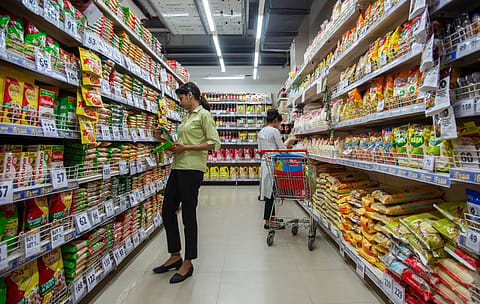Revival in consumer demand post-GST will show fully in Q3: Bank of Baroda
Deferred buying decisions in the second quarter will materialise fully in the third quarter.

With the production side of consumption showing significant sequential momentum in September—in anticipation of an optimistic outlook supported by major price reductions to customers offered by the government in GST reforms—revival in demand conditions is expected to have a full effect in the third quarter, according to a research note by the Bank of Baroda.
According to the note, deferred buying decisions in the second quarter will materialise in the third quarter—as most companies that have reported results have pointed out. The deferment will also be supported by a good sowing season and monsoon. Additionally, the Indian Meteorological Department’s forecast of a strong winter season is expected to drive demand for certain consumer goods.
The disaggregated production data (IIP) show that demand for consumer durables has been strong. While this is supported by moderation in prices, the GST 2.0 tax revision is expected to further bring prices down. The note cites white goods production, which increased in September compared to the year-ago period.
The production of TVs and refrigerators has posted a strong double-digit number. In the case of television, the stronger 11.4% growth visible in September also comes in the wake of an elevated base of 10.1%. It should be noted that, following the recent GST cut, this segment received a further boost by moving to a lower tax slab. This is further expected to boost production in the coming months.
Refrigerators, on the other hand, are posting buoyant growth, according to the research note. However, the note issues a caveat that a part of the growth is attributable to a negative base of -2.7% seen in September of last year. Yet, even on a seasonally adjusted basis, the sequential picture shows the September production number is buoyant at 14.7%.
ACs have witnessed a significant 11.3% increase. Here, year-over-year growth is impacted by a significantly high base of 37.9% growth seen in September of last year. “These data points speak of the fact that discretionary spending of consumers held ground buoyed by the favourable price effect and optimism surrounding the latest tax reform,” reads the note.
The production of gold jewellery maintained its strong double-digit pace in Sep’25, even amid a sharp price increase. In September, the international gold price went up by 42.7%, on a year-on-year basis and by 8.9% on a month-over-month basis. This recent surge is attributable to higher safe-haven demand amidst a volatile global policy environment.
Recommended Stories
Several items showed the impact of unfavourable base, such as hosiery products and shaving razors/ razor blades. “Here also the sequential picture sheds better light about frontloading of production cycle ahead of festivals and anticipating higher demand from recent tax changes. For the majority of items, the sequential increase is visible,” adds the note.
Even on a seasonally adjusted basis, all hosiery products, travel goods, shaving instruments, and jewellery witnessed a considerable jump. “Interestingly, for footwear, even a negative 1.7% year-over-year print seen in Sep’25 is negated by a strong sequential pickup both in the unadjusted as well as seasonally adjusted series. Other items such as tyres for scooter/Motorcycle, bottled water also reflect the similar momentum of “moving out” phenomenon, where even on a sequential basis, pickup is visible.”
In automobiles, during Navaratri, broad-based growth was evident across all categories. Auto, PV, and two-wheeler sales registered healthy year-on-year growth above 30%. Moreover, the highest sales were recorded during this period, as consumers would have pushed off their purchases to incorporate the GST rate reduction. More than 60% of total auto sales occurred during this period. Even the share of PV and two-wheeler sales during this period to total September sales was as high as 73% and 65%, respectively.
For FMCG companies, sales have picked up. Companies have attributed the same to positive macro fundamentals. Most of the FMCG companies also agreed that the majority of their portfolio will benefit, especially in the third quarter, due to the GST reform. It will unlock new opportunities by increasing consumers' disposable income and creating more opportunities for premiumisation. However, some cited transitory disruptions due to clearing out old price inventory.
(INR CR)
Consumer durables companies are also confident about growth. However, the current quarter showed some impact of the postponement of buying decisions in anticipation of further clarity over the pass-through of the GST rate cut. Thus, third-quarter numbers are expected to show the full impact.
